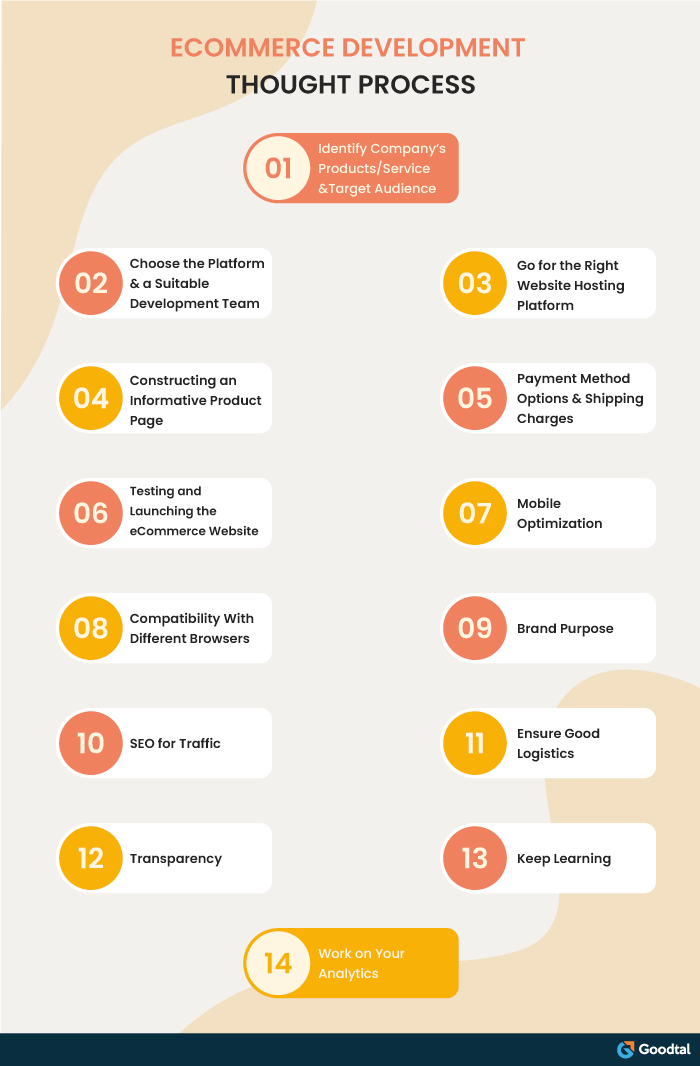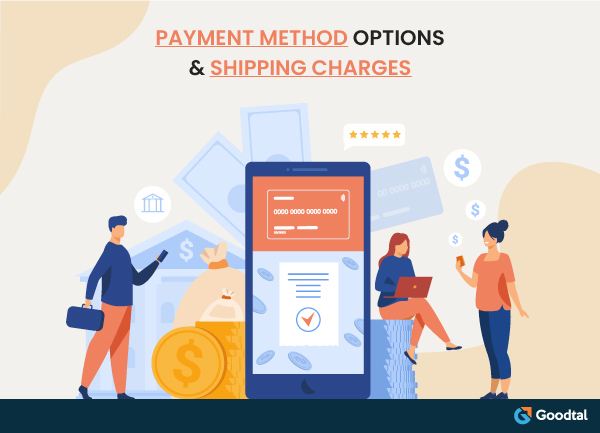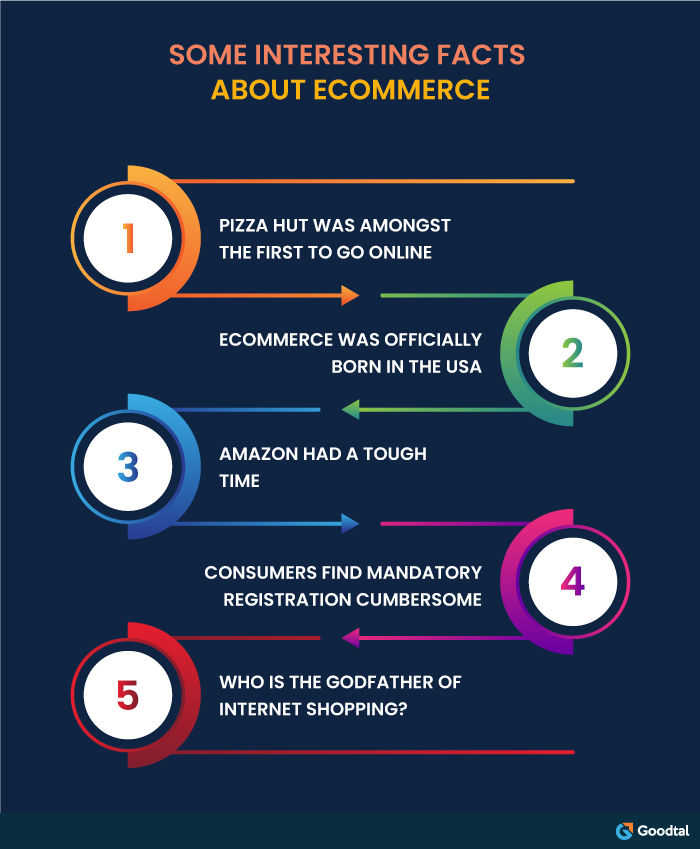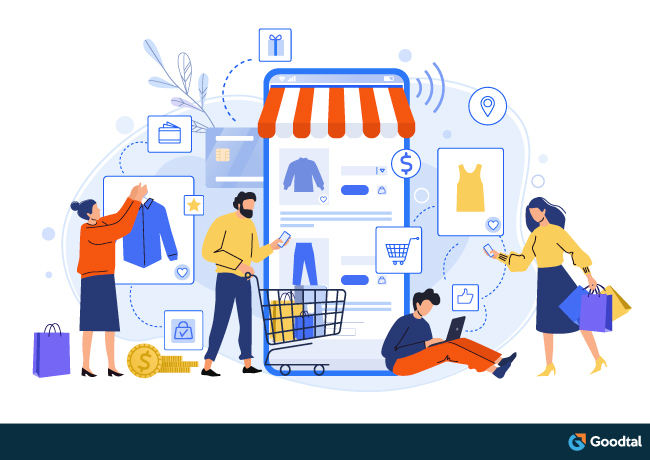
eCommerce stores are mushrooming all over the place, giving tough competition to each other. eCommerce stores boost sales further as the company can reach more customers. The Corona pandemic further increased their demand as people feared visiting stores to buy groceries, clothes, or other merchandise.
To survive & thrive, they rely a lot on Software Developers who weave together their Websites and Apps. eCommerce Developers need to have different mindsets & skills to build a successful eCommerce store. In this blog, we have a look at how eCommerce Developers visualize and design their products.
eCommerce Development Thought Process

1. Identify Company’s Products/Services & Target Audience
First & foremost, an eCommerce Developer should know what the company will sell in the eCommerce store. This will have an impact on the design & development of the eCommerce App/Website. Products/Services will have a target audience, depending on the nature of the product/service. For example, a fashion apparel eCommerce store’s target audience would be youngsters in the 18-35 Year age group. Once the target audience is ascertained, the look of the eCommerce App/website can be designed accordingly.
2. Choose the Platform & a Suitable Development Team
The next step would be to choose the right platform for your eCommerce store from options like Shopify, Magento, BigCommerce, etc. Having decided on the platform, the team who will work on eCommerce store development can be finalized.
The platform can be chosen based on Enterprise Resource Planning(ERP), Customer Relationship Management(CRM), and Database compatibility.
3. Go for the Right Website Hosting Platform
eCommerce store's domain name, server, and hosting, all have a say in the performance of your eCommerce store. The server should be able to provide good speed. The website features are of no use if the page loads slowly, as potential customers would leave as no one likes to wait. The host provider's recent uptime records should also be checked. Servers should be able to handle sudden traffic increases and be highly secure as they will handle payments and store clients’ data.
4. Constructing an Informative Product Page
The product page is an essential part of an eCommerce website and should be customized per the product type. The product's features, price, variants, usage, and warranty should be contained. The product page should be simple yet provide all the information about the product. Images from various angles and videos providing information about the product and usage should be a part of the product page.
5. Payment Method Options & Shipping Charges

An eCommerce store is incomplete without having a Payment Gateway and various payment options. The Payment Gateway should be secure & dependable. Payment Gateways which are slow or have high rates of failure will not be acceptable to the customers. Payment options should include mobile wallets like Google Pay, Credit Card, Debit Card, Netbanking, and Cash-on-Delivery.
An eCommerce store has different shipping charges depending on the type of product, its weight, size, etc. Some eCommerce stores also offer monthly, quarterly, or yearly shipping subscriptions for a fixed amount.
6. Testing and Launching the eCommerce Website
Once the eCommerce App or website is ready, it needs extensive testing to iron out all the bugs. All sections of the eCommerce website should function properly without snags, or else it will cost your business.
The checkout page should work flawlessly with all the payment options available for payment. All buttons, including Zoom-In & Zoom-Out, should work perfectly; otherwise, it will result in negative feedback. Testing should be done from the viewpoint of a customer.
7. Mobile Optimization
More consumers access eCommerce stores from mobile phones than laptops or Personal Computers. According to research, 53% of users browse on mobile but buy on desktops, and 37% of total revenue comes from mobile devices. Hence, the eCommerce website should be optimized for mobile as well.
8. Compatibility With Different Browsers
Users have smartphones with different Operating Systems and use different browsers to surf the eCommerce website. This requires compatibility across different Operating Systems and browsers to ensure a hassle-free experience. eCommerce developers should ensure that no user faces snags because of different browsers or OS.
9. Brand Purpose
Your eCommerce store will be your brand and should reflect your purpose, principles & ethics. If you want to improve your brand value, you should listen to your customers. The best way to know what customers want is to ask them to submit reviews about the products, payment options, refunds, and delivery time. A careful study of the reviews submitted by the customers will give a lot of insights, which can be used to increase traffic and sales.
10. SEO for Traffic
Search Engine Optimization is required to consistently rank high on Google and other search engines. The higher the rank, the eCommerce store will receive more traffic; therefore, the possibility of sales will increase. Hence, a team of SEO experts should either be hired in-house, or SEO tasks should be outsourced to a competent SEO agency.
11. Ensure Good Logistics
Nothing can irritate a customer more than a delayed delivery, multiple calls from the delivery agent asking about directions to the delivery location, or a damaged product. An aspiring eCommerce store should ensure that none of these happens and customers get the product on time & in perfect condition.
12. Transparency
Customers do not like wrong product information, hidden charges, or confusing policies, which spoil their online buying experience. Hence, it should be ensured that no such misinformation is displayed on eCommerce stores' Apps or Web pages.
13. Keep Learning
All industries are evolving very rapidly, and the eCommerce industry is no exception. The biggest mistake any eCommerce company can make is to become complacent and stop learning. eCommerce Developers should keep themselves well-versed with the latest technologies & trends. The eCommerce website/App should be updated periodically to incorporate the latest trends.
More reading: 20 eCommerce Development Trends That Will Dominate the Year 2022
eCommerce App Development requires a different approach as it is completely different from other apps. However, if the points mentioned above are followed, the eCommerce store will receive traffic and generate sales. eCommerce has just seen the tip of the iceberg, and there is a lot of scope for growth.
A good eCommerce store will always do well as it can have a much larger client base that is not restricted by geographical boundaries and time.
14. Work on Your Analytics
A lot of Data is generated these days, and Data means nothing if it is not analyzed and inferences are drawn from it. Data-driven decisions are more likely to be correct, and some companies specialize in Data Analytics. Big Data Developers can help eCommerce companies in making sense of their Data. Decisions related to pricing, offers, discounts, and sales can be taken based on Data Analytics.
eCommerce Apps are here to stay as there is a lot of scope for growth. Thus the right approach will help keep your eCommerce store competitive and increase sales. eCommerce apps will always be in demand, and the market share will only increase. However, eCommerce store owners should know Consumer is the King, and care should be taken that they are satisfied with the service of an eCommerce store.
“In 2021, retail eCommerce sales worldwide were 4.9 trillion USD & expected to grow by 50% over the next four years to 7.14 trillion USD by 2025.” - Statista
Some Interesting Facts About eCommerce

#1 Pizza Hut was Amongst the First to go Online
The humble telephone order was replaced by online ordering by Pizza Hut in 1994. Thus, Pizza Hut led the revolution, and today Multi-National food chains get more revenue from Apps than from dine-in.
#2 eCommerce was Officially Born in the USA
In 1984, CompuServe launched the first “Electronic Mall” in USA & Canada, making it the first electronic commerce service. Five years later, ‘Compumarket’ was launched by Sequoia Data Corp, which had the feature of paying with Credit Cards.
#3 Amazon had a Tough Time
Amazon was officially launched in 1995 as an online book store. However, it took the company 8 years to register a yearly profit. Today, Amazon is one of the most valuable companies in the world and a technology giant.
#4 Consumers Find Mandatory Registration Cumbersome
One of the most irritating situations in an eCommerce store can be you want to check out & pay for the goods purchased, and the website/app asks you to register by filling up a form first. To make things simple, some of the eCommerce stores now have registration-optional.
#5 Who is the Godfather of Internet Shopping?
Michael Aldrich is the Godfather of internet shopping and invented online shopping in 1979. The term eCommerce was coined later, but online shopping was invented a long time back, in 1979. It may sound puzzling, but online shopping has been around for more than 40 years.
Finally, Checking Out of the eCommerce Store…
As we have seen, you need to consider many factors for developing an eCommerce website or an App. Even if you use software like Shopify, WordPress, and plugins, developing a competent website/App is always challenging. Goodtal provides a list of eCommerce development companies that can develop good eCommerce websites for you.

eCommerce is booming, and still, there is a lot of growth potential. So, having an eCommerce store will be profitable for any company. However, a robust & scalable app/website is needed to compete as this is a niche market with a lot of competition. The app/website must be updated frequently to incorporate new technology or fix bugs. A new layout and better navigation are always a possibility. If an eCommerce store does not constantly adapt to the new market conditions, it will take no time for the company to lose market share.
